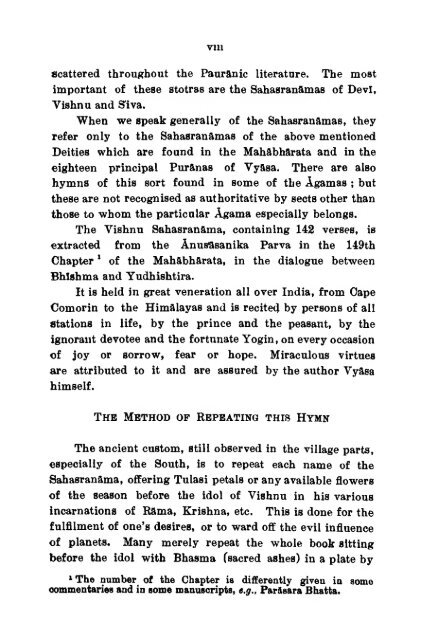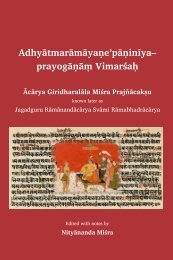Vishnu.Sahasranama.with.the.Bhasya.of.Sankaracharya_text
Vishnu.Sahasranama.with.the.Bhasya.of.Sankaracharya_text
Vishnu.Sahasranama.with.the.Bhasya.of.Sankaracharya_text
Create successful ePaper yourself
Turn your PDF publications into a flip-book with our unique Google optimized e-Paper software.
scattered throughout <strong>the</strong> Pauranic literature. The most<br />
important <strong>of</strong> <strong>the</strong>se stotras are <strong>the</strong> <strong>Sahasranama</strong>s <strong>of</strong> Devi,<br />
<strong>Vishnu</strong> and Siva.<br />
When we speak generally <strong>of</strong> <strong>the</strong> <strong>Sahasranama</strong>s, <strong>the</strong>y<br />
refer only to <strong>the</strong> <strong>Sahasranama</strong>s <strong>of</strong> <strong>the</strong> above mentioned<br />
Deities which are found in <strong>the</strong> MahabhSrata and in <strong>the</strong><br />
eighteen principal Puranas <strong>of</strong> VySsa. There are also<br />
hymns <strong>of</strong> this sort found in some <strong>of</strong> <strong>the</strong> Agamas ; but<br />
<strong>the</strong>se are not recognised as authoritative by sects o<strong>the</strong>r than<br />
those to whom <strong>the</strong> particular Agama especially belongs.<br />
The <strong>Vishnu</strong> <strong>Sahasranama</strong>, containing 142 verses, is<br />
extracted from <strong>the</strong> Anutfasanika Parva in <strong>the</strong> 149th<br />
Chapter * <strong>of</strong> <strong>the</strong> Mahabharata, in <strong>the</strong> dialogue between<br />
Bhlshma and Yudhishtira.<br />
It is held in great veneration all over India, from Cape<br />
Comorin to <strong>the</strong> Himalayas and is recited by persons <strong>of</strong> all<br />
stations in life, by <strong>the</strong> prince and <strong>the</strong> peasant, by <strong>the</strong><br />
ignorant devotee and <strong>the</strong> fortunate Yogin, on every occasion<br />
<strong>of</strong> joy or sorrow, fear or hope. Miraculous virtues<br />
are attributed to it and are assured by <strong>the</strong> author Vyasa<br />
himself.<br />
The Method <strong>of</strong> Repeating this Hymn<br />
The ancient custom, still observed in <strong>the</strong> village parts,<br />
especially <strong>of</strong> <strong>the</strong> South, is to repeat each name <strong>of</strong> <strong>the</strong><br />
<strong>Sahasranama</strong>, <strong>of</strong>fering Tulasi petals or any available flowers<br />
<strong>of</strong> <strong>the</strong> season before <strong>the</strong> idol <strong>of</strong> <strong>Vishnu</strong> in his various<br />
incarnations <strong>of</strong> Rama, Krishna, etc. This is done for <strong>the</strong><br />
fulfilment <strong>of</strong> one's desires, or to ward <strong>of</strong>f <strong>the</strong> evil influence<br />
<strong>of</strong> planets. Many merely repeat <strong>the</strong> whole book sitting<br />
before <strong>the</strong> idol <strong>with</strong> Bhasma (sacred ashes) in a plate by<br />
*The number <strong>of</strong> <strong>the</strong> Chapter is differently giveu in some<br />
commentaries and in some manuscripts, e.g., Parasara Bhatta.



